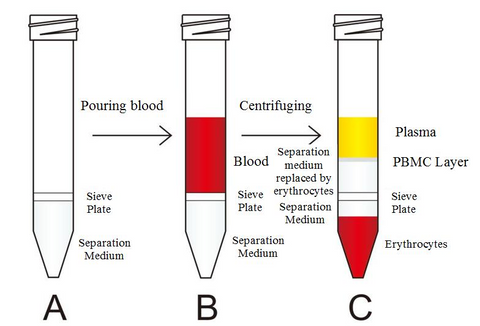You have no items in your shopping cart.
Note
To be used for separating lymphocytes from human peripheral anticoagulant blood.
1. The blood shall be collected at normal temperature, stored in an anticoagulant container at normal temperature (for not more than 2 hr) and separated at normal temperature, and shall not be kept in a 4℃ refrigerator.
2. The blood can be separated directly without the need for dilution. However, dilution does not influence the separation effect.
3. For a 15 ml separation tube, peripheral anticoagulant blood is not less than 3 ml; and for a 50 ml separation tube, peripheral anticoagulant blood is not less than 15 ml. If the blood is not enough, the use of the separation tube is not recommended, and the dilution of the blood cannot improve the separation effect.
| Catalog Number | Specification | Recommended sample size |
| 7922112 | 15 ml/vial×20 vials | 3-6 ml |
| 7922021 | 50 ml/vial×25 vials | 15-25 ml |
4. The blood cells removed from the plasma can be poured into the separation tube directly or after being diluted with normal saline to double volume, so as to separate PBMCs, but only if there are enough erythrocytes. For a 15 ml separation tube, there are at least erythrocytes equivalent to those contained in 3 ml of blood; and for a 50 ml separation tube, there are at least erythrocytes equivalent to those contained in 15 ml of blood.
5. If fewer PBMC layer or red blood cells are observed, to avoid cell loss, the washing frequency can be appropriately reduced to once. For other situations, it is recommended to wash twice.
Product Description
This product is used for cell separation and purification by density gradient sedimentation according to the differences in cell densities with the help of the separation medium and centrifugation. The cell gradient density separation medium produces a certain density gradient to pour the anticoagulant blood into the separation tube. After centrifugation, erythrocytes and granulocytes sink to the bottom of the tube; PBMCs (peripheral blood mononuclear cells, including lymphocytes and monocytes) float on the surface of the separation medium, and a small part of cells may suspend in the separation medium. Lymphocytes can be separated from the peripheral blood by absorbing the cells on the surface of the separation medium.
Main Compositions
The main compositions of the tube are ficoll, diatrizoic acid and PP or PE sieve plate.
Applicable Instrument
Horizontal rotor centrifuge.
Sample Requirement
The sample must be fresh anticoagulant blood which shall be collected by sterile operation and shall not be frozen or refrigerated in the processes of storage, handling and transportation.
Procedure
1. Inspect, as shown in Figure 1 (A).
Take out the separation tube, and observe whether there is free separation medium on the sieve plate material or air bubble below the sieve plate. If yes, centrifuge at 800 g for 1 min at 20℃.
2. Pour blood, as shown in Figure 1 (B).
The blood sample must be anticoagulant blood without the need of dilution.
3. Centrifuge at 800 g for 15 min at 20℃. Set relatively low acceleration and deceleration (If there are ten gears and the tenth gear is the highest, acceleration and deceleration shall be adjusted to the third).
4. After suctioning out a portion of the plasma, directly pour the remaining small amount of plasma, PBMC layer, and a small amount of separation medium above the sieve plate into a clean centrifuge tube.
As shown in Figure 1 (C), and the PBMC layer is below the plasma and above the separation medium.
5. Wash with RPMI 1640 for 1-2 times (20℃, 250 g, 10 min).
Resuspend the lymphocytes with 0.9% (W/V) normal saline or a suitable culture medium for use.

Figure 1: Process of Separating Blood with Lymphocyte Separation Tube for Human Peripheral Blood
Explanation of Test Results
Different performances of centrifuges of various brands and differences in temperature environments may have influence on the separation effect, so users can adjust the centrifugation revolution and the centrifugation time to find the best separation conditions (The specific separation conditions are determined by laboratories).
Limitations of Test Method
The experiment requires that the temperature of the sample, the separation medium and the separation environment is (20±5)℃ under a normal atmosphere.
1. The separation tube shall be kept away from light at normal temperature.
2. The optimum separation temperature is (20±5)℃, beyond which the separation effect will be affected.
Storage Conditions and Period of Validity
Kept unopened away from light at 2~30℃, valid for 2 years.
References
1. Boyum A. (1968): Separation of leucocytes from blood and bone marrow. Scand J. Clin. Lab. Invest. 21, Suppl. 97.
2. Harris R. & Ukayiofo EV. (1969): Rapid preparation for lymphocytes for tissue typing. Lancet 327, 7615.
3. Boyum, A. (1968): Isolation and removal of lymphocytes from bone marrow of rats and guinea-pigs.,Scand J. Clin. Lab. Invest., 21, Suppl.97, 91-109.
4. Zheng Dexian, Wu Kefu, Chu Jianxin. (1999): Modern Experimental Hematology Research Method and Technology. Peking Union Medical College Press.
Document
Lymphocyte Separation Tube for Human Peripheral Blood-Prefilled-Biosci™
When can I expect my order to ship?
Most orders are filled and shipped within 2-3 business days from the time they are received.
Our standard shipping usually take 2-5 days.
We also provide express shippping for time-sensitive deliveries.
Email contact@biofargo.com if you have any requirements.



